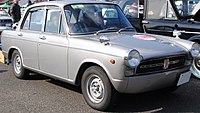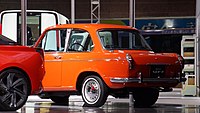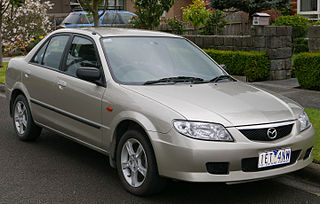
The Mazda Familia, also marketed prominently as the Mazda 323, Mazda Protegé and Mazda Allegro, is a small family car that was manufactured by Mazda between 1963 and 2003. The Familia line was replaced by the Mazda3/Axela for 2004.

The Toyota Starlet is a subcompact car manufactured by Toyota from 1973 until 1999, replacing the Publica, but retaining the Publica's "P" code and generation numbering. The first generation Starlet was sold as the Publica Starlet in some markets. In Japan, it was exclusive to Toyota Corolla Store dealers.
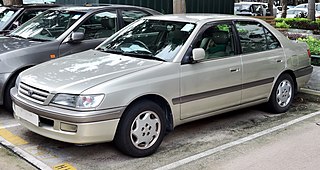
The Toyota Corona is an automobile manufactured by the Japanese automaker Toyota across eleven generations between 1957 and 2001. On launch, the Corona was Toyota's second-highest product in their range, just below the Crown. The Corona was marketed in the JDM at Toyota's Toyopet Store dealership channels, and the Corona was one of Toyota's first models exported to other global markets, followed by the smaller Toyota Corolla.
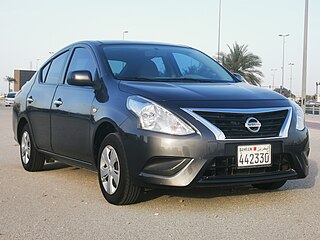
The Nissan Sunny is an automobile built by the Japanese automaker Nissan from 1966 till 2004. In the early 1980s, the brand changed from Datsun to Nissan in line with other models by the company. Although production of the Sunny in Japan ended in 2004, the name remains in use in China and GCC countries for a rebadged version of the Nissan Almera.

The Daihatsu Charade is a supermini car produced by the Japanese manufacturer Daihatsu from 1977 to 2000. It is considered by Daihatsu as a "large compact" or "supermini" car, to differentiate it from the smaller kei car compacts in its line-up, such as the Daihatsu Mira. In Japan, it offers buyers more interior space and a larger engine that allows for the car to also be used outside of urban areas. It replaced the Daihatsu Consorte, although the Charmant took over from the bigger-engined Consortes, and didn't share a platform with a Toyota product.

The Daihatsu Fellow Max is a small Japanese automobile in the Kei car class. Originally introduced as the Daihatsu Fellow, the name was partially retained for its successor, the Max Cuore (1977), and then revived in 2000 for the Daihatsu Max.

The Daihatsu Charmant is a subcompact sedan built by Daihatsu of Japan, based on the Toyota Corolla. It was succeeded by the Daihatsu Applause two years after Charmant production ended. The Charmant was heavily based on the E20 Toyota Corolla; model changes paralleled those of the Corolla. All Charmants were fitted with Toyota inline-four engines, ranging from 1.2 to 1.6 litres. The word charmant is French for "charming."

The Mitsubishi Minica is a model series of kei cars, produced by Mitsubishi Motors Corp. (MMMC) over five generations, from 1962 to 2011, mainly for the Japanese domestic market.

The Toyota Carina is an automobile which was manufactured by Toyota from December 1970 to December 2001. It was introduced as a sedan counterpart of the Celica, with which it originally shared a platform. Later, it was realigned to the Corona platform, but retained its performance image, with distinctive bodywork and interior — aimed at the youth market and remaining exclusive to Japanese Toyota dealerships Toyota Store. It was replaced in Japan by the Toyota Allion in 2001 and succeeded in Europe by the Toyota Avensis.

The Daihatsu Hijet is a cab over microvan and kei truck produced and sold by the Japanese automaker Daihatsu since 1960. Despite the similarities between the Hijet name and Toyota's naming scheme for its trucks and vans, the name "Hijet" has been in use for Daihatsu's kei trucks and microvans since 1960, over two decades before Toyota took control. "Hijet", when transliterated into Japanese, is very similar to "Midget", one of Daihatsu's other mini-trucks. According to Daihatsu, the name "Hijet" was created to imply that the vehicle offers higher performance than the Midget. The Hijet competes in Japan with the Honda Acty, Mitsubishi Minicab, Nissan Clipper, Subaru Sambar and Suzuki Carry.
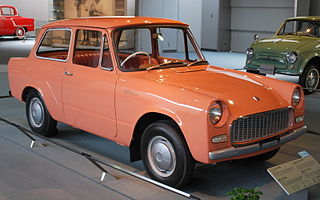
The Toyota Publica is a small car manufactured by the Japanese company Toyota from 1961 until 1978. Conceived as a family car to fulfill the requirements of the Japanese Government's "national car concept", it was the smallest Toyota car during that period and was superseded in that role by the Toyota Starlet, which itself started out as a version of the Publica. It was available as a 2-door vehicle only, but in a selection of body styles, ranging from the base sedan through a station wagon, convertible, coupé and even a coupe utility (pickup), which outlived the other models by a decade, and spawned other models, such as the Toyota Sports 800 and the Toyota MiniAce.
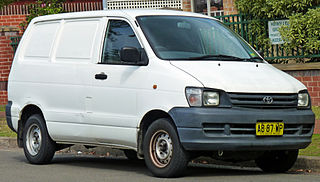
The Toyota LiteAce and TownAce are a line of light commercial and derivative passenger vans produced by the Japanese car manufacturer Toyota. These vehicles originally utilized the cab-over-engine configuration, although since 1996 a semi-cab-over arrangement has featured instead. The LiteAce launched in 1970 as light-duty truck, with commercial and van/wagon body variants added in 1971. In 1976, Toyota released the larger TownAce van/wagon that derived from the LiteAce; a TownAce truck arrived later in 1978. Between 1982 and 1992, the series accommodated the MasterAce Surf—an upscale TownAce passenger wagon.

The Mitsubishi Colt 800 is the first of a series of passenger cars with a fastback/hatchback design produced by Mitsubishi Motors from November 1965. It was introduced as a two-door fastback sedan, the first such design in the Japanese market. The series was discontinued in 1971, after the introduction of the company's Galant sedan but without a real replacement.
The Mitsubishi Colt (A20) was one of their first series of passenger cars produced by Shin Mitsubishi Heavy-Industries, Ltd, one of the companies which would become Mitsubishi Motors. Built from 1963 until 1970, they were available in four body styles and on two different wheelbases, with gradually increasing engine displacements 1000, 1100, 1200, and 1500. After a May 1968 facelift, they were marketed as the "New Colt". Along with the smaller, fastback Colts they formed the mainstay of Mitsubishi's passenger car lineup in the 1960s. With the late 1969 introduction of the new, larger Colt Galant, the outmoded Colt-series soon faded away, eventually replaced by the smaller Mitsubishi Lancer as well. The dimensions were kept small so as to provide Japanese buyers the ability to purchase a car that complied with the Japanese Government compact car dimension regulations and to keep the annual road tax obligation affordable.

The Corolla E20 was the second generation of cars sold by Toyota under the Corolla nameplate. Launched in May 1970, it featured "coke bottle styling" and had a longer 2,335 mm (91.9 in) wheelbase. The front suspension design was improved greatly, using a swaybar, however the rear remained relatively similar. The Corolla became the second-best selling car in the world that year. Grades for sedan were Standard, Deluxe, and Hi-Deluxe. The coupé was offered in Deluxe, SL, SR, and Levin trim levels.

The Corolla E30/E50 was the third generation of cars sold by Toyota under the Corolla nameplate. It was built from August 1974 to July 1981 and marked Toyota's greatest growth in the United States in the wake of the fuel crisis. In addition to its sister model, the Sprinter, there was a redesigned-body version built by Toyota affiliate Daihatsu, called the Daihatsu Charmant. While there were certain fourth-generation models with a longer model life, this generation, when considered as a whole, was the longest-lived one, possibly due to the worldwide recession in the 1970s. A large range of cars was built using this chassis, including Corollas, Sprinters, Daihatsu, and the sporty Levin and Trueno models with the DOHC motor, with a fuel injection upgrade added to Japanese Levin models in January 1977.

The Corolla E70 was the fourth generation of cars sold by Toyota under the Corolla nameplate.
The Daihatsu New-Line was a compact series of pickup trucks and vans built by Daihatsu from 1963 until 1968. They were based on the Daihatsu Hijet "keitora" and microvans, although they were somewhat larger and sturdier. The 797 cc inline-four engine also seen in the Daihatsu Compagno was fitted, rather than the 356 cc two-stroke unit seen in the Hijet.
The Daihatsu Hi-Line/F series is a series of compact trucks, manufactured and sold from 1960 to 1972. This truck series was competed with Toyota Stout, Nissan Junior, Prince Miler, Hino Briska or Mazda B series.

